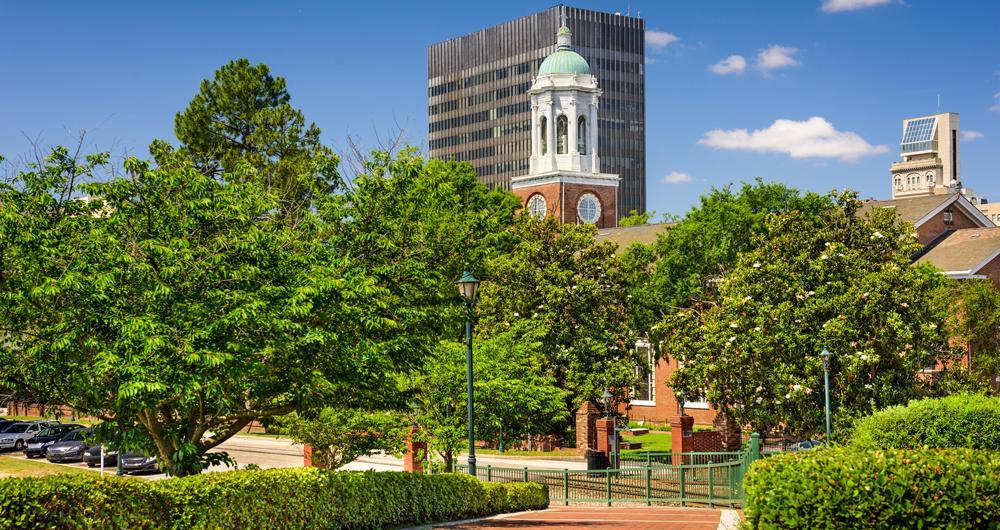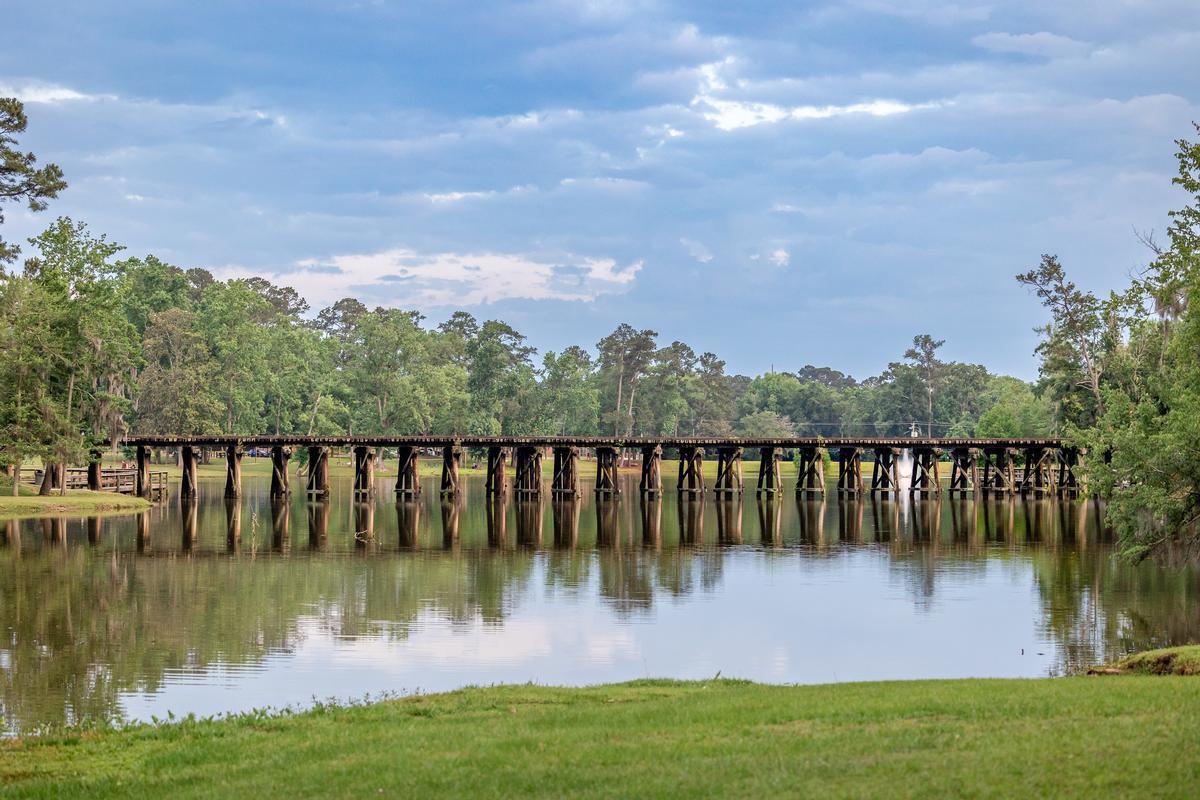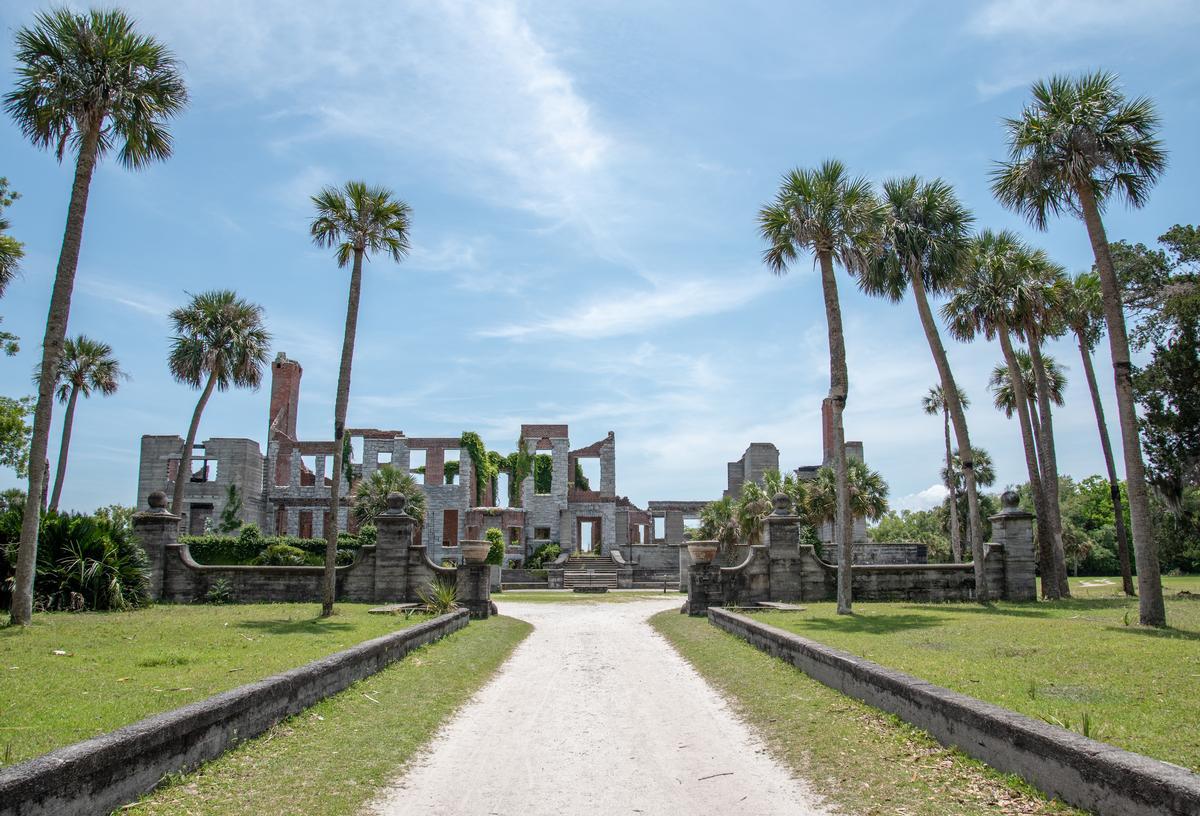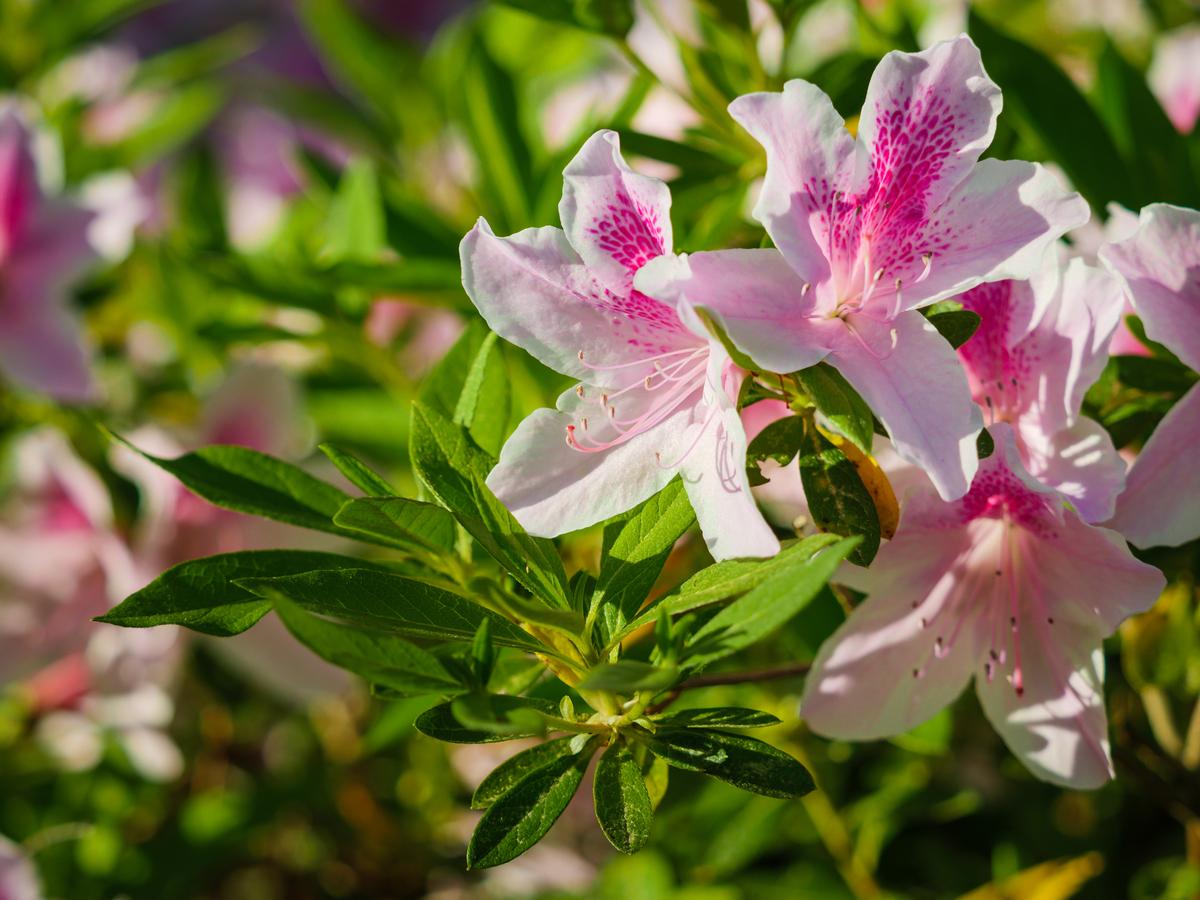Best Places to Visit in Georgia, USA

When people ask me where they should go in Georgia, I'm a little biased. I always want to plan another trip to Georgia's sandy beaches, waterfalls and lakes that I explored during two months while living there as a local. But just as mazing are Georgia's cities!
Wherever you decide to go in The Peach State, you’ll find yourself wrapped in Southern charm, natural beauty, and a mix of old-world tradition with modern energy. From my many trips exploring this diverse state (from mountains to coastline weeks at a time) here’s my collection of favorite destinations and experiences.
- Best Places to Visit in North Georgia (Mountains & Foothills)
- - Blue Ridge - Toccoa Falls Waterfall - Lucille's Mountain Top Inn & Spa
- Best Places to Visit in Metro Atlanta
- - Atlanta - Marietta - Alpharetta
- Best Places to Visit in Central & East Georgia
- - Macon - Athens - Augusta - Madison
- Where to Go in South Georgia
- - Thomasville
- Best Places to Visit in Coastal Georgia
- - Tybee Island - Savannah - Driftwood Beach - Cumberland Island
Best Places to Visit in North Georgia (Mountains & Foothills)
This region is perfect when I'm in the mood for hiking, waterfalls, and a romantic weekend getaway surrounded by nature.

1. Blue Ridge
We absolutely love Blue Ridge, and have been many times. This is a great small town for slowing down and relaxing on vacation and it quickly became one of my favorite stops in Georgia when I moved to the South.
It was an easy, low-stress drive from Atlanta (under 2 hours north by car) which I thought made it the perfect spontaneous getaway. You'll also find it near the Tennessee and North Carolina borders, making it an easy day trip destination for many people.
What made Blue Ridge special was how effortlessly we could slip into nature. In fact, one of my favorite days was exploring the nearby trails and waterfalls, followed by a slow afternoon back in town. I'd definitely recommend planning some time around browsing Main Street’s historic brick storefronts from the early 1900s. Antique shops, craft galleries, and the Swan Drive-In Theatre (open since 1955!) gave this trip a nostalgic flavor I adored. We stayed for two nights at the Blue Ridge Inn Bed & Breakfast ($189), an 1890 Victorian home which I found very unique and comfortable.
In addition, my son loved riding on the Blue Ridge Scenic Railway ($52, 26-mile round trip along the Toccoa River in vintage coaches).
My personal highlight was lunch at Harvest on Main, where I ordered the trout BLT (bacon, tomato, and flaky grilled trout on toasted sourdough) - It came with rosemary roasted potatoes and a slice of house-made pickle.

2. Toccoa Falls Waterfall
Welcome to Georgia’s most breathtaking natural wonder! Toccoa Falls was one of those places that takes your breath away. Located in the scenic foothills of the Blue Ridge Mountains on the campus of Toccoa Falls College, this 186-foot waterfall is taller than famous Niagara Falls and cascades dramatically into a quiet pool below. Surrounded by forested hills, this is such a serene escape into the beauty of North Georgia.
I loved that the falls are located directly on the college grounds, with a short and easy walking path leading to the viewing area. The accessibility makes it perfect for families, couples, and solo travelers alike. We thought it was cool how the gentle trail allows you to take in the sights without a strenuous hike.
If you want to stay overnight, while there aren’t hotels at the falls themselves, Downtown Toccoa offers boutique stays and bed-and-breakfasts (from $92/night), while larger resorts and lodges are available in surrounding areas like Clarkesville or Tallulah Falls.
Beyond the falls, explore the town of Toccoa with its historic downtown, local shops, and museums. Outdoor lovers can continue to nearby trails in the Chattahoochee National Forest, or take a short drive to Tallulah Gorge State Park for even more dramatic views and hiking opportunities.

3. Lucille's Mountain Top Inn & Spa - 1 hour 35 minutes from Atlanta, GA
This is one of my favorite weekend getaways from Atlanta, and honestly I think it's one of the best mountain escapes in the U.S. because it truly lives up to its name—you really do feel like you’re perched on top of the world! Best of all, tucked into the Blue Ridge Mountains, this place felt like a warm hug after a long week.
I felt completely captivated the moment I reached Lucille’s Mountain Top Inn & Spa, perched high above the Blue Ridge Mountains with views that felt absolutely magical and very romantic.
I loved how our romantic room for two days had floor-to-ceiling windows and a private balcony. My favorite moments were watching the sunrise paint the mountains in shades of gold and pink.
I spent our first afternoon at the spa where I had a 60-minute massage and soaking in the peaceful atmosphere, and it was the coolest way to recharge surrounded by nature.
I enjoyed the gourmet breakfast each morning, freshly prepared and served with care, which made the start of every day feel joyful and indulgent.
I liked exploring the nearby wineries, hiking trails, and towns.
I appreciated the little touches—like fresh cookies in the afternoon, soft robes waiting in my room, and the warm hospitality of the staff—that made me feel cared for.
I ended each evening sitting on the terrace with a glass of wine, watching the stars emerge above the mountains, and it felt like time had slowed down just for me.
To book, check availability or prices for the 4-star Lucille's Mountain Top Inn & Spa
Returning to the inn’s cozy fire-lit lounge and mountain-view decks after a busy day was my favorite highlight.
Best Places to Visit in Metro Atlanta
I love the world-class dining, culture, and entertainment alongside walkable downtowns and green spaces.

4. What to Do in Atlanta
Ready for a culture-packed getaway? Check out Atlanta — a real standout! What I love about visiting Atlanta is that it’s easy to get around, packed with history and culture, and offers plenty of unique activities to fill an entire week! This city is such a cool mixture of Southern tradition and modern innovation. My mind was blown by the contrast of tall skyscrapers on one hand and historic leafy neighborhoods on the other. I love the food scene in Atlanta - if you are a foodie this is the first place you'll want to visit in Georgia! We usually start our road trip here. We stayed at the 4-star Georgian Terrace ($189) for two days, an iconic 1911 hotel across from the Fox.
I spent the first couple of hours exploring the Atlanta BeltLine, a lively urban trail (a former railway corridor!) with murals, cafés, and greenery that connects several neighborhoods. My personal highlight was the Atlanta History Center, where we learned a lot about history from the Civil War through the Civil Rights Movement.
If you’re spending just one day in Atlanta, I think you should consider starting downtown with the Martin Luther King Jr. National Historical Park. Walking through this area is incredibly powerful—you can visit Dr. King’s childhood home, Ebenezer Baptist Church, and learn about Atlanta’s role in the Civil Rights Movement. From there, it’s easy to explore nearby attractions like Centennial Olympic Park, the World of Coca-Cola, or the Georgia Aquarium, depending on your interests.
Last time we caught the Brookhaven Cherry Blossom Festival in March which celebrated spring so well with music, food and a lively social scene. In addition, we stopped at Swan Coach House for amazing Afternoon Tea.
If you love the ocean, Georgia Aquarium is one of the most amazing things to see here! It won numerous awards like the WAZA Conservation Award for its whale shark program and the Evoqua Water Sustainability Award.
In the afternoon, my personal highlight was checking out Ponce City Market for an hour. It's actually open all day, from 10am to 9pm (11m to 8 pm on Sundays), so you can go any time. Set in a historic Sears building, the market offers eclectic food stalls and shops and I just enjoyed looking around a bit.
Local tips: To get around Atlanta, I suggest using MARTA whenever it makes sense, especially if you’re staying downtown or midtown. MARTA trains and buses are affordable (around $2.50 USD one way) and connect major areas like the airport, downtown attractions, and midtown neighborhoods. While Atlanta is known as a driving city, MARTA can be quicker than sitting in traffic, and it’s a stress-free way to explore the city’s core.
I recommend wearing comfortable walking shoes and starting early—Atlanta is spread out, but if you plan well, you can see a lot without feeling rushed.
I’ll warn you that Atlanta can feel deceptively close on a map, but distances add up quickly. Early on, we found it helpful to focus on one or two areas rather than bouncing all over the city. Taking a guided tour during our first visit really helped us understand the layout and history while making the most of our time. Now that we know the city well after so many visits, exploring on our own is easy!

5. Marietta, Georgia
This is one of the coolest small cities to visit near Atlanta! I love that it offers a bit of everything — a charming town square, great restaurants, and historic sites too. Marietta is a Southern town with lots of history and hometown warmth, red-brick downtown square, and an easygoing energy perfect for a day trip (or a romantic weekend getaway!) in Georgia.
We drove about 30 minutes northwest from Atlanta to Marietta, and I started exploring at the lively Marietta Square, where boutiques, antique shops, and locally owned restaurants encircle a park with a fountain. We enjoyed our time at the Marietta Square Market, a restored warehouse turned food hall. We sample Southern comfort food and even bought some for a picnic lunch we had a few hours after.
History runs deep here and you can see it come to life at the Gone With the Wind Museum. In the afternoon, we hiked along part of Kennesaw Mountain National Battlefield Park (2,965 acres, free entry) which offers interpretive trails that make the Civil War history come alive.
My room at the Stanley House Inn ($169) for two days was my personal highlight, a Victorian B&B right off the square.
Best Places to Visit in Central & East Georgia
My favorites in this region are college-town energy in Athens, Southern charm in Madison, and rich heritage along the Savannah River in Augusta.

6. Alpharetta
Ready for a food-and-fun-filled day just outside Atlanta? For me, Alpharetta is one of the absolute best day-trip destinations in Georgia. We started at Avalon, where tree-lined paths, glowing storefronts, and buzzing cafés created the kind of atmosphere that instantly puts you in a great mood.
My favorite part was strolling hand in hand through the open-air streets, stopping whenever something caught our eye and letting the day unfold naturally around us.
Downtown Alpharetta had a warm, storybook feel, with brick sidewalks, historic touches, and so many great restaurants it was hard to choose where to stop. We shared a memorable meal at The Southern Porch, enjoying Southern-inspired dishes that felt indulgent and comforting at the same time—exactly the kind of food you talk about long after the plates are cleared.

7. Macon, Georgia - 1 hour 35 minutes from Atlanta
What I love about visiting Macon is that it’s easy to get around and has more than enough history, music, and Southern charm to fill an entire weekend! I recommend wearing comfortable walking shoes and starting your day early, since many of the best spots are close together but worth taking your time to explore.
Getting to Macon is straightforward if you’re coming from Atlanta, with the drive taking about an hour and a half via I-75. Once you’re in town, having a car is the easiest way to get around, though the downtown area itself is very walkable. I like driving here because parking is simple and it makes hopping between attractions quick and stress-free.
If you make the trip to Macon, I think you should definitely tour the opulent Hay House, known as the “Palace of the South”, explore African American art at the Tubman Museum, and spend some time walking through downtown. Macon is deeply connected to music history and is also home to beautiful architecture, local shops, and great Southern food. You can stroll along the Ocmulgee Heritage Trail, visit Ocmulgee Mounds National Historical Park, stop for live music, explore museums, and enjoy classic comfort food—all without feeling rushed. We loved stopping for lunch at The Rookery, a Macon institution with famous burgers and shakes! Afterwards, step into rock & roll history at the Allman Brothers Band Museum at The Big House to round out your day!
My personal highlight was Cherry Street with its shops, murals, and live music.

8. Things to Do in Athens, GA
Ready for a fun, culture-filled getaway? Check out Athens, GA — a real standout! We absolutely love Athens, GA, and have visited several times. Athens is best known as the home of the University of Georgia, but it’s also one of the most influential music towns in the country and has a laid-back charm that’s hard not to love.
After flying into Hartsfield–Jackson Atlanta International Airport (ATL) and driving 1 hour 30 minutes east through pine forests, the air was warm, the pace unhurried, and every corner seemed to hum with creativity.
Starting the day at Mama’s Boy was my favorite, the beloved breakfast spot where locals and travelers alike line up for biscuit sandwiches, creamy grits, and sweet tea served with genuine Southern kindness.
I spent two lively days soaking up the best of Athens — catching indie shows at the legendary 40 Watt Club, browsing vinyl at Wuxtry Records, and wandering through the State Botanical Garden of Georgia.
My favorite museums were at the Georgia Museum of Natural History and the Athens Institute for Contemporary Arts.

9. Augusta, Georgia
Set along the Savannah River, this is one of the most unique and elegant cities I’ve explored in Georgia, and I think it’s one of the absolute best weekend getaways in the state. Why? First off, Augusta has historic neighborhoods, a revitalized downtown, and artsy pockets. In addition, we adored beautiful river views here, and a legacy tied to both music and golf by hosting the famous Masters Tournament .
We drove about 2 hr 15 min east from Atlanta to Augusta, one of Georgia’s oldest cities, founded in 1736 where we stayed two amazing nights at 3-star The Partridge Inn ($179), a historic 1836 hotel perched on the hilltop. While there, we walked along the Augusta Canal National Heritage Area (free trails, boat tours $14) to learn how this 1840s waterway powered textile mills.
Downtown, touring the boyhood home of President Woodrow Wilson (1858, $5 tours) was my personal highlight where Young Woodrow Wilson (then Thomas Woodrow Wilson) lived from around 1860 until 1870 (ages about 4–14) during his formative years overlapping the Civil War and Reconstruction.
For lunch, we headed to Hildebrandt’s, a family-run deli just a few blocks away, and I ordered the German roast beef sandwich on rye, with a side of warm potato salad spiced with mustard and onion.
If you are wondering when to visit, spring is especially popular thanks to azaleas in bloom and the Masters buzz, but fall and winter, for me, are quieter and great for sightseeing.
If you’re visiting for a day or two, you’ll need to be selective about what you see. Personally, the Augusta Riverwalk tops my list. It’s a scenic stretch along the Savannah River with walking paths, gardens, and great views, especially around sunset.

10. Madison - 1 hour and 15 minutes from Atlanta
Ahh Madison — one of the South’s best-kept secrets. This charming small town is often called the prettiest town in Georgia, and honestly, it lives up to the hype. Known for its graceful antebellum (pre-Civil-War) architecture, quiet streets, and warm Southern hospitality, Madison feels like stepping into a slower, more elegant era. If you love history, this is a day trip that absolutely deserves a spot on your list.
What I love about Madison is how effortlessly historic it feels. The town dates back to the early 1800s and somehow survived the Civil War well preserved, which means the historic district is packed with stunning old homes, columned mansions, and moss-draped trees. Walking through downtown honestly feels like wandering through a living museum.
After arriving in one hour on a day trip from Atlanta, I spent a joyful day wandering around the Madison Historic District, toured the Heritage Hall mansion, and browsed local art at the Madison-Morgan Cultural Center.
Food-wise, I love that Madison punches above its weight for a small town. From classic Southern comfort food to charming farm-to-table spots, it’s easy to turn a simple visit into a full afternoon of eating, wandering, and soaking up the atmosphere.
Our afternoon drive along the Antebellum Trail was my personal highlight, a scenic route linking Georgia’s most picturesque historic towns.
Where to Go in South Georgia
This area offers a slower pace and deep Southern charm, perfect for a day trip reset!

11. Thomasville, Georgia
Tucked away in the rolling Red Hills of southwest Georgia, Thomasville might not be on every traveler’s radar—but, for me, that’s exactly what makes it special. Moreover, this historic city quickly surprised me with its culture, food scene, and beautifully preserved downtown.
Thomasville may be small, but it packs far more character than you’d expect. In fact, known as the “Winter Resort of the South” during the Victorian era, Thomasville has long attracted visitors seeking warm weather, good food, and gracious hospitality.
Getting to Thomasville is fairly straightforward if you’re already in South Georgia. If you’re flying in, Tallahassee International Airport is the closest major option, and we found that renting a car is the easiest way to explore the area at your own pace.
So what is there to see in Thomasville? A great place to start is Downtown Thomasville. We caught the town as it preparing for spring events — hints of the Rose Festival to come, with wreaths of blossoms appearing on storefronts and banners fluttering downtown.
I spent two gentle days exploring The Rose City’s layers from our base at 3-star Hampton Inn Thomasville — browsing antique stores and indie boutiques on Broad Street, sipping sweet tea at Grassroots Coffee, and visiting the legendary Big Oak, a centuries-old tree so grand it feels almost alive with memory. For me, wandering through Pebble Hill was a standout, a beautifully preserved estate surrounded by gardens.
And of course, Thomasville takes food seriously. The city is known for its Southern cuisine, and we loved the way places like Jonah’s Fish & Grits and Sweet Grass Dairy Cheese Shop highlight local flavors and ingredients. Whether you’re craving comfort food or something more contemporary, I can guarantee that you won’t leave hungry.
Money-Saving Tip: – Many of Thomasville’s best experiences are either free or inexpensive. Walking downtown, browsing local shops, and enjoying public spaces cost nothing, and attractions like the History Center and Pebble Hill are reasonably priced. If you plan your visit around local festivals or farmers markets, you can experience the city’s culture without stretching your budget at all.
Best Places to Visit in Coastal Georgia
Georgia's beaches are among my favorites in the world, and I've spent some of the most magical weekends here!

12. Tybee Island
It's not really possible to talk about the places to visit in Georgia without this beautiful island! We love the outdoors, and if you’re craving salty air, sandy beaches, and laid-back coastal vibes, Tybee Island delivers in the best way.
Tybee Island felt worlds away from Savannah though it’s only about 30 minutes down the road. When friends ask me where to go on a beach vacation in Georgia, Tybee Island is the first choice that pops into my head.
We stayed at 3-star DeSoto Beach Hotel ($159), the island’s only beachfront hotel, and we loved that our room for two nights overlooked the Atlantic.
One of the island’s highlights is Tybee Island Beach, which stretches across several distinct areas. North Beach is quieter and more scenic, while South Beach is lively and close to shops, restaurants, and the iconic pier. Tybee Island is perfect, whether I'm in the mood for swimming, sunbathing, fishing, or simply watching the waves roll in.
When I was feeling active, we climbed the steps of the Tybee Island Light Station (178 steps, $12 admission), my personal highlight. Nearby, history lovers should check out Fort Pulaski National Monument, where you can walk through a well-preserved Civil War–era fort surrounded by coastal wetlands.
Lunch at The Crab Shack is not to be missed, a unique historic eatery with wonderful sunset views. We were there during the annual Tybee Island Pirate Fest in October which was extra fun.

13. Things to Do in Savannah
It goes without saying that this is one of the most charming cities in the United States, and it quickly became one of my favorite places to visit when I moved to the South. From its moss-draped oak trees to its historic architecture and slow Southern pace, Savannah has a way of pulling you in almost immediately.
Even as someone who’s visited their fair share of historic cities, I was completely taken by its atmosphere. If you’ve ever been curious about classic Southern charm mixed with coastal vibes, Savannah is absolutely worth the trip.
What I found especially interesting about Savannah is how walkable and thoughtfully laid out the historic district is. The city is built around 22 picturesque squares, each with its own personality, monuments, and shady benches. These squares connect everything (museums, churches, cafes) making Savannah feel both intimate and easily explorable.
The best way to experience Savannah is simply by walking through the Historic District. You’ll pass beautiful row houses, hidden courtyards, and centuries-old landmarks at every turn. My favorite spot is Forsyth Park, especially near the iconic white fountain. It’s the perfect place to slow down, people-watch, and really soak in the city’s relaxed energy.
We flew about 3.5 hours from Austin (950 miles) into Savannah and for two days, we stayed at the 3-star Marshall House ($199), Savannah’s oldest hotel (1851), with original wood floors and gas lamps!
I loved how just a short walk from my hotel brought me into the heart of the historic district steeped in old-world Southern charm. I started my morning at Foxy Loxy Café, nibbling on warm kolaches in the courtyard before going out and exploring.
Midday, I joined the Savannah Taste Experience food tour, which threaded through local eateries and taught me the stories behind local staples (like pralines and shrimp & grits!). Later, I rolled up my sleeves at Chef Darin’s Kitchen Table for a hands-on class—part cooking lesson, part Savannah history, fully delicious.
My personal highlight was dinner; a classic Lowcountry affair at The Olde Pink House.
The only caveat: the city’s popularity means some venues can feel crowded at peak times.

14. Driftwood Beach, Jekyll Island
I thought this beach was one of the most otherworldly coastal landscapes I’ve ever seen! it was incredibly beautiful with gnarled, weather-bleached driftwood trees scattered like sculptures along the sand. The mix of bleached trunks, tidal pools, and the endless horizon gave the place an almost surreal, timeless feel, especially in the soft light of sunrise and sunset.
We drove about 1 hr 40 min south from Savannah (90 miles on I-95) to Jekyll Island (population 1,300), once the exclusive retreat of America’s gilded-age millionaires.
Before heading to the beach, I toured the Jekyll Island Historic District (240 acres, $9 daily parking fee, grand “cottages” built by Rockefellers and Pulitzers). We stayed at the Jekyll Island Club Resort ($229) for two days, the restored 1888 clubhouse that once hosted the country’s elite.
For me, what makes Driftwood Beach so fascinating is how it came to be. I learned that years of erosion reshaped this part of the island, leaving behind sun-bleached oak and pine trees that now sit tangled and twisted along the sand. You'll see for yourself that no two pieces of driftwood look the same!
Driving is really the only practical way to get here, and once you arrive, access to Driftwood Beach is straightforward with nearby parking. There’s no boardwalk or major facilities, which I think is part of the charm—this is a place that feels raw and untouched. Just be sure to wear sturdy shoes, as the sand can be uneven around the driftwood.



15. Cumberland Island
Cumberland Island felt like stepping into a wild, world, an untouched barrier island where you are greeted with windswept dunes and pristine beaches.
We drove about 45 minutes north from Jacksonville (35 miles on I-95) to St. Marys, then caught the ferry (45 minutes, $20 round trip) to Cumberland Island (Georgia’s largest barrier island, 36,000 acres of protected wilderness). We stayed in St. Marys at the Riverview Hotel ($139) for two days, a 1916 inn facing the waterfront.
I spent the day exploring maritime forests, salt marshes, and miles of empty shoreline. Yes, wild horses really wandered around freely... One of the highlights was walking through the haunting ruins of Dungeness Mansion, a once-grand Carnegie estate that you can visit.
I found this island to be one of the places to visit in Georgia when I moved to the South.
We were thrilled when we spotted crabs scuttling across the tidal flats, a reminder of how untouched this island still is by civilization.
Local tip: The island’s sheer size means it’s impossible to see it all in one visit so don't worry about packing it all into one day trip!


Booking Checklist
1. Book Your Flight - I use Expedia because I like their mobile app with my itinerary. They've helped me re-book flights on many occasions. Once you reach their Gold tier, support is especially good.
2. Book Your Hotel - I use Booking.com or Expedia, depending on my destination.
3. Book Your Rental Car - I use Expedia.
4. Book your tours on Viator or Get Your Guide.
5. If you are planning to visit more than three national parks in the next 12 months, buy the America the Beautiful Pass.
